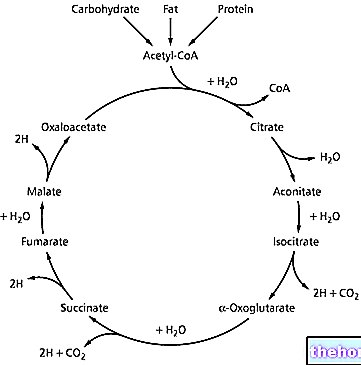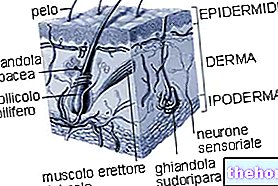Generality
The tricuspid valve is located between the right atrium and the right ventricle of the heart. Its job is to regulate blood flow through the orifice that connects these two cardiac compartments.
Some references to the anatomy of the heart
Before proceeding with the description of the tricuspid valve, it is useful to recall some characteristics of the organ in which it is located: the heart.
The heart is an unequal, hollow organ made up of involuntary striated muscle tissue. Its main function is to move the blood in the vessels; for this reason it is comparable to a pump, which, by contracting, pushes the blood towards the various tissues and organs. It has a shape that resembles that of an inverted pyramid. At birth, the heart weighs 20-21 grams and, in adulthood, reaches 250 grams in women, and 300 grams in men. The heart resides in the chest, at the level of the anterior mediastinum, rests on the diaphragm and is slightly moved to the left. It is surrounded by the pericardium, a serous-fibrous sac, which has the task of protecting it and limiting its distensibility. The wall of the heart is made up of three superimposed tunics which from outside to inside take the name of:
- Epicardium. It is the outermost layer, in direct contact with the serous pericardium. It consists of a superficial layer of mesothelial cells that rests on the underlying layer of dense connective tissue, rich in elastic fibers.
- Myocardium. It is the middle layer, made up of muscle fibers. Cells in the myocardium are called myocardiocytes. Both the contraction of the heart and the thickness of the heart wall depend on it. It is necessary that the myocardium is correctly supplied and innervated, respectively by a vascular and a nervous network.
- Endocardium. It is the lining of the heart cavities (atria and ventricles), consisting of endothelial cells and elastic fibers. To separate it from the myocardium, there is a thin layer of loose connective tissue.
The internal conformation of the heart can be divided into two halves: a right and a left. Each part consists of 2 distinct cavities, or chambers, called atria and ventricles, inside which blood flows.
The atrium and ventricle of each half are placed one above the other, respectively. On the right side, there are the right atrium and the right ventricle; in the left side, there are the left atrium and the left ventricle. To clearly divide the atria and the ventricles of the two halves, there are, respectively, an interatrial and an interventricular septum. Although the blood flow in the right heart is separated from the left side, the two sides of the heart contract in a coordinated way: first the atria contract, then the ventricles.
The atrium and ventricle of the same half are instead in communication with each other and the orifice, through which the blood flows, is controlled by an atrioventricular valve. The function of the atrioventricular valves is to prevent the reflux of blood from the ventricle towards the atrium ensuring unidirectional blood flow. The mitral valve belongs to the left half and controls the flow of blood from the left atrium to the left ventricle. The tricuspid valve resides, however, between the atrium and ventricle of the right side of the heart.
In the ventricular cavities, both right and left, there are two other valves, called semilunar valves. In the left ventricle resides the aortic valve, which regulates blood flow in the left ventricle-aorta direction; in the right ventricle the pulmonary valve takes place, which controls the flow of blood in the right ventricle-pulmonary artery direction. Like the atrioventricular valves, these too must ensure unidirectional blood flow.
The affluent vessels, ie those that carry blood to the heart, "discharge" into the atria. For the left heart, the affluent vessels are the pulmonary veins. For the right heart, the tributaries are the superior vena cava and the inferior vena cava.
The effluent vessels, that is, those that make the blood flow from the heart, depart from the ventricles and are precisely those controlled by the valves just described. For the left heart, the effluent vessel is the aorta. For the right heart, the effluent is the pulmonary artery.

The blood circulation, which sees the heart as the protagonist, is the following. The blood rich in carbon dioxide and poor in oxygen reaches the right atrium through the hollow veins, which has just supplied the organs and tissues of the body. From the atrium, the blood reaches the right ventricle and enters the pulmonary artery Through this route, the blood flow reaches the lungs to oxygenate and get rid of carbon dioxide. After this operation, the oxygenated blood returns to the heart, in the left atrium, through the pulmonary veins. From the left atrium it passes to the left ventricle, where it is pushed into the aorta, that is the main artery of the human body. Once in the aorta, the blood flows to all the organs and tissues, exchanging oxygen with carbon dioxide. Depleted of oxygen, the blood enters the venous system to return to the heart again, in the "right atrium, to" recharge ". And so a new cycle is repeated, the same as the previous one.
The movements made by the blood occur following a relaxation phase followed by a contraction phase of the myocardium, that is, the heart muscle. The relaxation phase is called diastole; the phase of contraction is called systole.
- During diastole:
- The cardiac musculature of the atria and ventricles, both on the right and on the left, is relaxed.
- The atrioventricular valves are open.
- The semilunar valves of the ventricles are closed
- The blood flows, through the tributary vessels, first into the atrium and then into the ventricle. The transfer of blood does not take place in its totality, as a portion remains in the atrium.
- During systole:
- The contraction of the cardiac musculature occurs. The atria begin and then the ventricles. More precisely, we speak of atrial systole and ventricular systole:
- The amount of blood that was left in the atria is pushed into the ventricles.
- The atrioventricular valves close, preventing blood reflux into the atria.
- The semilunar valves open and the ventricular muscles contract.
- The blood is pushed into the respective effluent vessels: pulmonary veins (right heart), if it is to oxygenate; aorta (left heart), if it needs to reach tissues and organs.
- The semilunar valves close again after the blood has passed through them.
Diastole and systole alternate during blood circulation and the behaviors of the heart structures, regardless of whether the blood is in the right or left half of the heart, are the same.
To complete this overview of the heart, two other topics of considerable importance remain to be mentioned. The first concerns how and where the myocardial contraction nerve signal arises. The second concerns the vascular system that supplies the heart.
The nerve impulse that generates the contraction of the heart originates in the heart itself. In fact, the myocardium is a particular muscle tissue, endowed with the ability to self-contract. In other words, the myocardiocytes are able to generate by themselves the nerve impulse for the contraction. The other striated muscles in the human body, on the other hand, need a signal from the brain to contract. If the nerve network that conducts this signal is interrupted, these muscles do not move. The heart, on the other hand, has a natural cardiac pacemaker at the junction between the superior vena cava and the right atrium, known as a sinoatrial node (SA node). stimulate the contraction of the heart of patients suffering from certain heart disease. To correctly conduct the nerve impulse, born in the SA node, to the ventricles, the myocardium has other pivotal points: in succession, the signal generated passes through the atrioventricular node (node AV), for the bundle of His, and for the fibers of Purkinje.
The oxygenation of heart cells belongs to the left and right coronary arteries. They originate from the ascending aorta. Their malfunction results in ischemic heart disease. Ischemia is a pathological condition characterized by the lack of or insufficient blood supply to a tissue. Once the blood has exchanged oxygen with the cardiac tissues, it enters the venous system of the cardiac veins and the coronary sinus, thus doing return to the right atrium. The entire vascular network of the heart resides on the surface of the myocardium, in order to avoid their constriction at the moment of cardiac muscle contraction; situation, the latter, which would alter the blood flow.
Function and anatomy of the tricuspid valve
The tricuspid valve is located in the orifice that connects the right atrium and the right ventricle of the heart. It is one of the two atrioventricular valves of the heart, along with the mitral one. It allows blood to flow between the atrium and ventricle in a unidirectional way. In fact, at the moment of atrial systole, the right atrium contracts and pushes the blood through the open valve orifice into the ventricle. At the time of ventricular systole, the tricuspid valve closes, preventing reflux. The surface of the orifice of the tricuspid valve measures 7-8 cm2.
The opening and closing mechanism depends on the pressure gradient, i.e. the pressure difference, existing between the atrial and ventricular compartment. Indeed:
- When blood enters the atrium and atrial systole begins, the pressure in the atrium is higher than ventricular. Under these conditions, the valve is open.
- When blood enters the ventricle, the pressure in the ventricle is higher than in the atrium. Under these conditions, the valve closes, preventing reflux.
These two situations are common to both atrioventricular valves of the heart.
The structure of the tricuspid valve consists of:
- The valve ring. Circumferential in shape, it delimits the valve orifice.
- Three flaps, or cusps (hence the name of tricuspid valve). Based on their position, the cusps are classified into septal, inferior and anterior-superior. On the edges of the flaps there are particular anatomical structures, the commissures, which favor the closure of the orifice. The cusps are made up of connective tissue, rich in collagen and elastic fibers. They do not have direct vascular systems and, not even, controls, equally direct , of nervous and muscular type.
- Papillary muscles. They are extensions of the ventricular myocardium and ensure stability to the short tendons.
- Tendon cords. They serve to join the valve flaps with the papillary muscles. As the rods of an umbrella prevent it from turning outward in strong winds, the tendon cords prevent the valve from being pushed into the atrium during ventricular systole.
The proper functioning of these valve components requires considerable synergy. A "morphological anomaly can compromise the correct opening-closing mechanism of the valve, which we remember to be a passive event dependent on pressure (neither the papillary muscles nor the tendon cords are able to actively open and close the atrioventricular valves)
Pathologies
The most common pathologies that can afflict the tricuspid valve are:
- Tricuspid stenosis. It is a narrowing of the valvular orifice, due to the fusion of the commissures, or to a morphological change of the tendon cords.
- Tricuspid insufficiency. A lesion occurs at the level of one of the structural elements of the valve: cusps, valvular ring, tendon cords and papillary muscles.




























